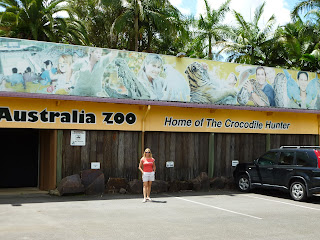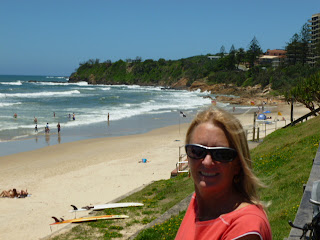
"Crikey!" (as in Wow!) Queensland, Australia is a cool place to visit.
I thought for sure we'd hear at least one person utter that phrase while we were wandering around Queensland, Australia for two weeks...but I guess only the person who is most associated with the expression "crikey," champion crocodile hugger Steve Irwin, used it on a regular basis. Sadly, Steve can no longer exclaim it. "Crikey" and Irwin's legend live on, however, at the Australia Zoo in Beerwah, an hour's drive north of Brisbane just off the Bruce Highway
.
Tom had some business meetings and work to take care of for his current project in Gladstone, Australia (construction of an LNG plant) so he took a few days vacation and flew over early and I tagged along for fun.
We started our adventure in Brisbane staying at a B&B for two nights.
Lucerne on Fernberg Our hosts, Brian and Helen, were outstanding. They were so friendly, sociable, and helpful, by the time we left, we felt more like "guests" than customers.

Our bed was in a separate guest house behind their historic Queenslander-style home, with a bedroom, living area, bathroom and a kitchen nook stocked with breakfast items and snacks. We were within walking distance of the Central Business District (CBD), many restaurants, and a fantastic walking/running/cycling trail.
Actually, the very first part of our adventure was renting a car and
driving on the left side of the highway. What a weird sensation and experience that was the first time...and for the whole two weeks, actually. But we managed just fine once we got the hang of it...and with lots of concentration by both the driver and the passenger to always make sure we were on the correct side of the road.
Apparently, Australians have a hard time knowing which side to be on, too, as we saw signs like these all over the state.
It rained the first two days we were there, but from our Brisbane base and with umbrellas borrowed from Brian and Helen, we were able to blend in with the locals while we used our feet to explore the CBD, the south side of the Brisbane River, the local eateries and the new Bicentennial Bikeway and Walkway, which goes for miles alongside the Brisbane River.
Brian kindly loaned us his GPS and even programmed it for our excursions out in the country to the Lone Pine Koala Sanctuary and Mount Coot-tha. This is what Brisbane looks like on a rainy day from the top of Mt. Coot-tha.
We loved the koala sanctuary, especially having the chance to interact with the animals. Scroll down to see why and get your oohs and aawwws ready.
One of the first things we learned here is that koalas are not bears, they are marsupials, along with kangaroos, wallabies, wombats and the Virginia opossum. Marsupials are mammals but they are different because they have pouches in which their young finish developing.
There's a baby in there somewhere...see the extra legs?
Aren't they cute? Aawww. YOLO!!
 The last part of our trip was spent in Gladstone, an industrial town and port. The highlight of this part of the visit was an all day snorkel trip to Lady Musgrave Island at the southern end of the Great Barrier Reef. We rode out on a charter boat, docked at a pontoon float, and hopped into an aquarium of tropical fish.
The last part of our trip was spent in Gladstone, an industrial town and port. The highlight of this part of the visit was an all day snorkel trip to Lady Musgrave Island at the southern end of the Great Barrier Reef. We rode out on a charter boat, docked at a pontoon float, and hopped into an aquarium of tropical fish.























.jpg)
.jpg)






.jpg)


